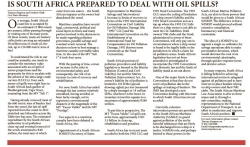IS SOUTH AFRICA PREPARED TO DEAL WITH OIL SPILLS? - Tamryn Simpson2017-10-16 IS SOUTH AFRICA PREPARED TO DEAL WITH OIL SPILLS? - Tamryn Simpson
On average, South Africa’s coast line is occupied by an estimated 12 000 vessels per annum, either passing through or visiting one of its many ports. Of these vessels, many are tankers collectively carrying an estimated 30 million tons of crude oil, the rest, up to 126 000 metric tons of fuel. To understand the risk to our coastline annually, one needs to consider the monetary value associated with an oil spill of minor proportions and the propensity for this to escalate with the advent of the ultra-large crude carriers (ULCCs). Four such minor oil spills were right here in South Africa’s back garden of Bloubergstrand, Cape Town, emanating from the MV “Seli 1â€. Having already removed most of the 660 metric tons of bunker fuel from the vessel, the last oil spill reported from the vessel in 2012 stretched one kilometre across the Tableview bay area. The estimated expenditure by the South African authorities in oil pollution clean-up and eventual removal of the wreck amounted to R40 million, the total sum of which came from one source â€" the South African taxpayer as the owner had abandoned the vessel. Maritime casualties have several legal, commercial, political and social layers to them and many parties involved in the decisions to be made regarding pollution prevention, possible salvage and eventual wreck removal. The decision on how to best manage a maritime casualty inevitably takes time. In the case of the MV “Seli 1†it took four years. With the passing of time, comes an increase in the risks to environmental safety, and consequently, the risk of an increase in costs of recovery and rehabilitation. For now, South Africa has sailed through the last century relatively unscathed, having avoided, or been lucky enough, not to experience environmental disasters of the magnitude of the MT “Exxon Valdez†and the MT “Prestigeâ€. Two aspects to a maritime casualty have been debated in South Africa, the: 1. Appointment of a South African SOSREP (Secretary of States Representative in Maritime Salvage and Intervention) 2. Increase in limits of recovery in terms of the 1992 International Convention on Civil Liabilit for Oil Pollution Damage (the “1992†CLC) and the International Convention on the Establishment of an International Fund for Compensation for Oil Pollution Damage, 1992 (known more commonly as the Fund Convention). South Africa’s present oil pollution prevention and liability legislation is housed in the Marine Pollution (Control and Civil Liability) Act and the Marine Pollution (Intervention) Act. An owner’s liability for oil pollution is limited to 133 SDRs (special drawing rights) per ton (measured by a ship’s tonnage) or 14 million SDRs, whichever is the lesser. In monetary terms this equates to a maximum of approximately R240 million. To put this in perspective, The MT “Exxon Valdez†oil spill cost, at the time, approximately USD 3.5 billion in clean up, rehabilitation and penalties. South Africa has in recent years acceded to both the 1992 CLC and 1992 Fund Convention. The 1992 CLC raises the ceiling of limitation of a ship owner’s liability and the 1992 Fund Convention acts as a top up where the 1992 CLC falls short or a ship owner is not able to meet its CLC liabilities. Both owners’ P&I clubs and the Fund, administered in terms of these Conventions, will only pay out in circumstances where a ship owner is found to be legally liable in the jurisdiction in which a claim for oil pollution arises. South African legislation has not yet been amended or promulgated to incorporate the 1992 Conventions into domestic law and the limits of liability stand as set out above. One of the major limits to these Conventions is that they do not cover oil pollution due to the spillage or leaking of bunkers. The IMO has developed a new Convention dealing with this issue to which South Africa has not yet acceded. Currently, extensive intervention powers are provided to the South African Maritime Authority (SAMSA) to guard against pollution of the sea by harmful substances that are likely to be discharged from a ship or a tanker. SAMSA’s role, and perhaps limited to those powers in the South African Marine Pollution Acts, are akin to those powers that would be given to a South African SOSREP. The difference is that a SOSREP would proceed without extensive consultation, bureaucracy and financial constraints. The idea of a SOSREP is to appoint a single co-ordinator for salvage operations able to make preventative decisions, which would decrease the cost of an environmental catastrophe, through quicker response times and decisive action. In many respects, South Africa is falling behind in achieving international norms to safeguard against oil pollution and to have reserves in place besides relying on ship owners and their P&I clubs. The South African Maritime Law Association is alive to these issues and is, through a sub-committee, making representations to the National Department of Transport, in an effort to modernise and improve South Africa’s position. For more information please contact Tamryn Simpson on: T: 031 536 8500 Email: tsimpson@coxyeats.co.za www.coxyeats.co.za |
IS SOUTH AFRICA PREPARED TO DEAL WITH OIL SPILLS? - Tamryn Simpson
Copyright © 2024 KwaZulu-Natal Top Business
